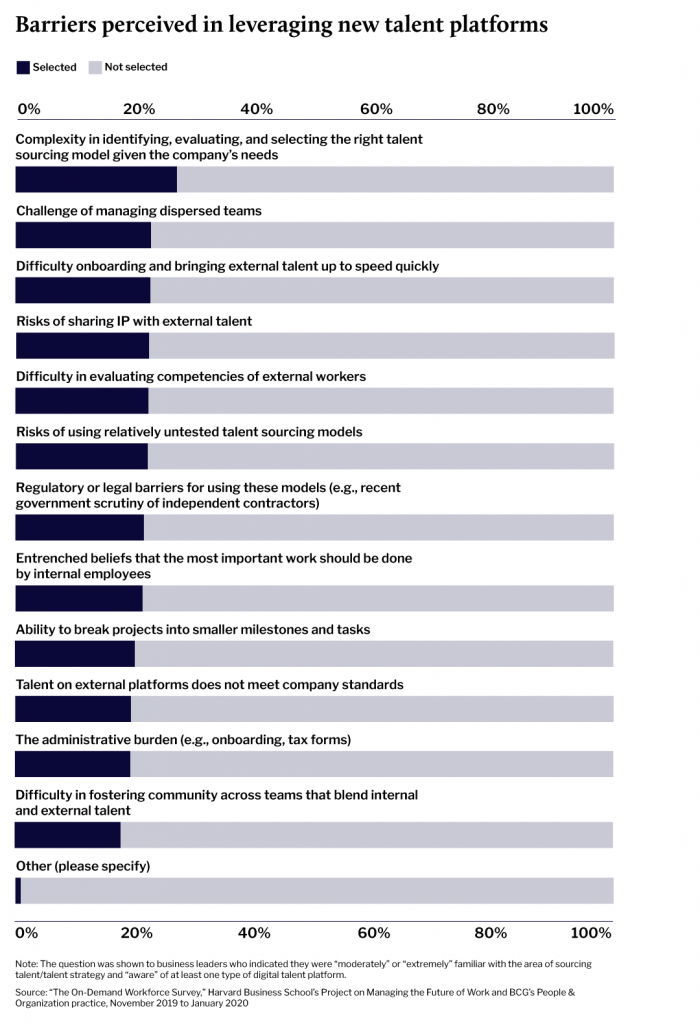3 Notable Findings from Harvard Business School’s Study of the On-Demand Workforce

The right talent, in the right place, at the right time, is the equation for success in today’s world.”
– Building the On-Demand Workforce, Harvard Business School & BCG
Researchers from Harvard Business School and Boston Consulting Group asked over 700 business leaders about their efforts to build a flexible workforce with on-demand talent platforms. This week, those researchers released their findings in a 32-report called Building the On-Demand Workforce.
“As early-adopter companies have become more comfortable with shopping for talent in these digital marketplaces, they have begun moving toward new, more flexible, agile organizations—ones that are built not on fixed costs and head counts but on a blended mix of full-time and part-time workers: the ‘on-demand workforce,’” according to the report.
The benefits of the on-demand workforce, the authors write, include increased labor flexibility, accelerated speed to market, and innovation through new business models. At Catalant, we’ve seen the market for on-demand talent booming as organizations — under pressure from competitors, new technologies, and a global pandemic — rethink their strategic workforce planning priorities. The study validates what we’ve seen firsthand, but also includes a few findings that surprised us.
1. 90% of business leaders say on-demand talent platforms provide a competitive edge.
Not only that, but half of all business leaders expect to work more with on-demand talent platforms in the future, and 60% said they would prefer to rent, borrow, or share talent with other companies.
That means most business leaders are looking at companies like Anheuser-Busch InBev, which uses experts sourced via Catalant to move quickly into new markets and products, and anticipate adopting a similar approach to workforce planning. Their reasons go well beyond cost-cutting and improving efficiency, according to the study.
“The survey showed that, increasingly, companies expect to use new talent models not just to improve performance within the confines of their current business models but also to experiment with new business models built around using an on-demand workforce. Certainly, a majority of C-suite leaders shared that vision for a future that relies on new talent models,” the study reveals.

2. C-level executives are already living in the future.
While overall enthusiasm for on-demand talent platforms is notable, researchers found a gap between C-level executives and frontline managers, many of whom are less optimistic about moving toward a flexible workforce. In fact, CEOs were twice as likely as frontline managers (VP and Directors) to predict their usage of on-demand talent platforms would grow in the near future.
Why? The researchers point primarily to a schism between business leaders and the human resources functions at their organizations.
“The survey showed clearly that human resources departments were only doing what they were tasked to do: hire, evaluate, and compensate employees within the jobs, laws, and company systems as they are currently defined. In conversations with companies where on-demand workforces were being blended in more successfully, we sometimes heard that it was despite HR, rather than because of traditional HR,” according to the report.
Perhaps HR isn’t to blame. Giving up decades of tradition and culture is difficult, and many frontline leaders are wrestling with the challenge of implementing a new talent model that fundamentally alters the reality of how work gets done and by whom.
That’s where on-demand talent platforms need to step up. Large-scale talent transformation requires more than just a directory of available experts and firms. At Catalant, we’ve invested heavily in our software platform to provide a seamless experience where business leaders can connect business objectives, work, and resources in a single digital environment. Without clear visibility into who is doing what work, and for what objectives, those hiring on-demand workers are left with a mess of disconnected parts.

3. Organizational capability is the biggest predictor of success.
Analyzing the challenges of implementing a flexible workforce model, researchers found that the organizations reporting better results with on-demand talent platforms were those that had built out the right capabilities internally.
What are the right capabilities? Let’s start with an organizational ability to clearly define work. “In a typical organization,” the researchers write, “it can be hard to hand off tasks cleanly.” To be successful with on-demand talent platforms, companies need to be able to break down work into well-defined units and manage them accordingly. At leading organizations, that requires an investment in training for frontline managers.
“Unilever educated its senior leaders on reconstructing workflows to enable the use of talent platforms. When Enel adopted its open innovation approach, it quickly learned that, to be effective, it first had to train employees how to ask the right questions. That requires training employees to pose questions with the right level of clarity and detail so that they resulted in more effective outcomes,” the report states.
Another necessary capability is understanding the skills an organization has in-house already. At Shell, for example, leaders use the Catalant Platform to better document the skills and interests of internal employees, so they can match those employees to opportunities more quickly and efficiently.
Organizations also need to build the capability to work with on-demand talent platforms in accordance with their own legal and compliance requirements. For most, that will mean partnering closely with a platform partner that offers enterprise support via master services agreements, job classification services, demand planning, and more. At Catalant, we developed an enterprise offering based on our experience serving more than 30% of the Fortune 100.
Finally, the researchers say, the adoption of a flexible workforce should be driven by a C-level leader within the organization. While they remain agnostic about the functional area responsible for leading, the important part is to lead from ahead.
“To be successful, the change requires a leader who models the new capabilities required of all employees—a leader with the ability to recognize and shed the constraining dogmas of the past and the eagerness and creativity to embrace the possibilities of the future,” according to the report.
The Future of Work and On-Demand Workforce
The world is moving to new talent models, driven by technological advancements, cultural changes, and the profound impact of the COVID-19 pandemic. Smart organizations are already working with trusted on-demand talent platforms to build their internal capabilities and manage a blended workforce of in-house and on-demand talent.
While the changes necessary to build these capabilities may seem daunting, the research is clear that the value far outweighs the cost. Or, as the study from Harvard Business School puts it:
“Companies will find those costs worth bearing when they realize how on-demand freelance talent can be essential to their continued viability. To harness the full potential of an on-demand workforce, companies will need to embrace the disruption of digital talent platforms, just as they would reorganize while adopting any important new technology.”